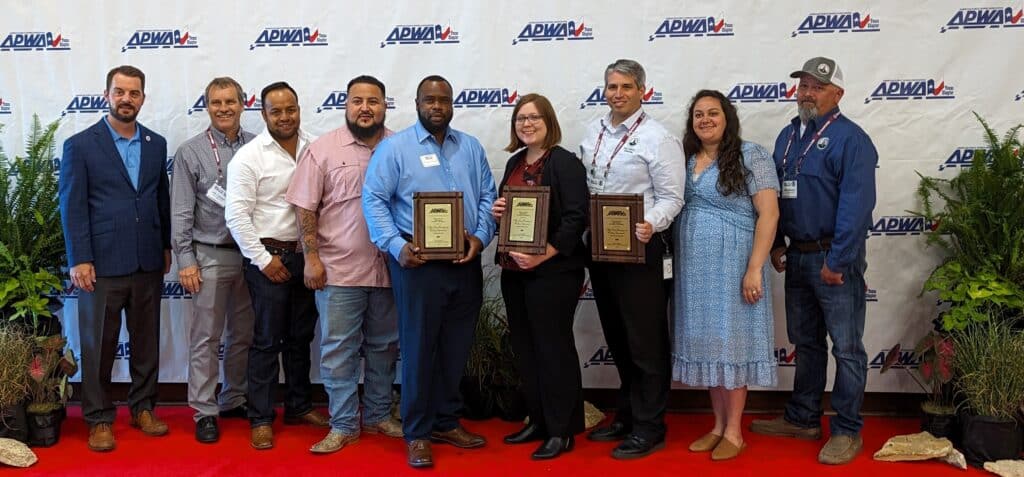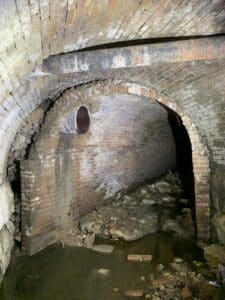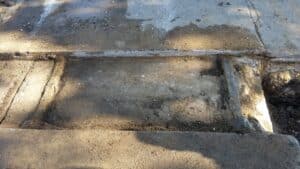Private Drains and Buried Tracks: Solving Unusual Stormwater Challenges
The American Public Works Association, Texas Chapter, named Waxahachie’s College Street Drainage and Roadway Improvements a Project of the Year for 2023 in the Environment, $2M-$5M, category.

As the City of Waxahachie worked with Freese and Nichols on a Drainage Master Plan in 2020, it became clear that the drainage system on College Street needed immediate attention. The area had a history of flooding, and two failures had occurred on a private storm system that also conveyed public stormwater. City inspections identified several locations with potential for more significant failures. Minor repairs to the private storm system over the years did not address the flooding risks.
After review of the storm analysis and site investigation, the City opted to move ahead with design of a detailed solution.
But unusual challenges accompanied this project, focused along North College Street from Parks Avenue to Water Street — primarily private property obstacles. The existing drainage infrastructure consisted of a private storm drain system located under the private properties on College Street. The system also crossed under the Union Pacific Railroad (UPRR) to outfall at a channel approximately 3,500 feet upstream of the confluence with Waxahachie Creek.
After reviewing the possible options, associated costs and impacts to private property, the City preferred a solution that didn’t require crossing the railroad because of cost and time considerations.
Developing Solution Options

The team performed a detailed drainage analysis of the area to develop several alternatives to improve drainage and address the potential risk to private properties. An InfoWorks ICM 2-D model helped determine the flooding impacts of College Street under existing conditions and evaluate options for the proposed project improvements. This model approach allowed for evaluation of the capacity of the proposed system, impact to structures under proposed conditions, and feasibility of the proposed system alignment within the highly urbanized project area.
The modeling showed significant flooding throughout the area, with 10 structures within the inundation limits of the 25-year storm event. The main flooding cause was the existing storm drain system: It had been built in segments and used varying pipe sizes and materials, which reduced the pipe capacity and resulted in significant inundation along College Street.
Using record data and on-site observations, the project team confirmed that a significant portion of the existing storm drain system was located on commercial properties and ran beneath multiple structures as well as the UPRR crossing. The location made it difficult to maintain and improve the system, so the best option was to move the storm drain system to the city-owned right-of-way.
Relocating the storm drain to College Street and diverting the discharge to an existing channel at Smokey Lane, just upstream of the UPRR, would provide a 25-year level of service. The system would consist of 2,020 LF of proposed storm drain, ranging in size from a 60-inch reinforced concrete pipe to a 7-foot-by-6-foot reinforced concrete box. The team determined that a 100-year level of service would not be cost-effective for the City’s limited budget and could not be constructed with the College Street right-of-way. And a 25-year level of service would provide the flood protection needed.
The City also used construction of the new storm drain improvements to update existing clay pipe sewer lines and make roadway improvements. This limited road closures and saved on construction costs while providing needed infrastructure upgrades.
Finding the Buried Tracks

The design team wanted the alignment of the new system to minimize disturbance of sewer and other utility lines. But three sets of railcar tracks buried under the pavement on College Street posed a problem. The tracks were no longer used and would have to be removed if they conflicted with the proposed storm drain placement. Limited information about the tracks meant the design team didn’t know their exact location.
To provide the contractor with the best possible representation of the work involved in the project, the City exposed the track to determine the depth of the concrete base, and the design team developed an estimate of the quantity and cost of track removal, with the understanding that the precise location of the tracks would be verified during construction.
The City also coordinated with the nonprofit Historic Waxahachie and Ellis County to preserve portions of the historic rail, and business owners collected rail pieces to incorporate with reconstruction amenities.
Coordinating With the Community
Thorough planning and direct communication between the City and project team helped keep residents informed during the course of the project. The City frequently provided design and construction progress updates at City Council meetings and on the City website.
In a demonstration of public support and appreciation, community members of the group Love Your Neighbor provided free lunches for the construction crew working on the College Street project.
Protecting the Environment
The solution the City chose was designed to outfall to a creek at Smokey Lane, and it was important that existing conditions would not be harmed by additional discharge from the proposed improvements. The 2D modeling results indicated that diverting College Street drainage to the Smokey Lane outfall would not significantly impact the downstream channel’s velocity or water surface. To further protect the channel, rock riprap was installed at the proposed outfall to prevent erosion.